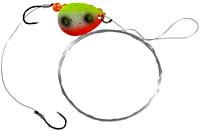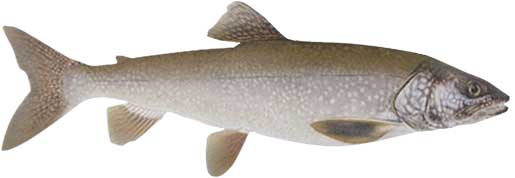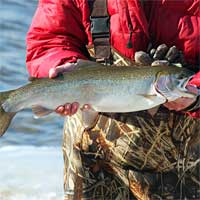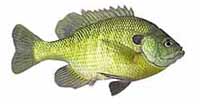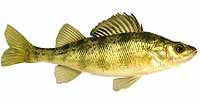Fishing Report For Fort Peck Lake, MT
By Rick Seaman
Last updated on .

Fishing Reports
Popular Fish Species Fort Peck Lake, MT
Walleye
Current Report: Good
FALL. Fall brings cooler temperatures to shallow water, drawing walleye and baitfish shallower. Walleye continue to be a major draw for anglers to Fort Peck Lake. Locals report catching nice walleye on long points, flats along the river and creek channels, and structure off shore. Jigs, swimbaits, spoons, crankbaits, jerkbaits, and spinnerbaits are all historically good for catching walleye this time of year. Early Fall finds them in 10 to 20 feet of water. Later in Fall, they move out slightly deeper. Dragging jigs, bottom bouncers, or worm harnesses with nightcrawlers or leeches, around ledge drop-offs is catching walleye fairly consistently. Watch for the bigger walleye to be slightly deeper than the majority of the school.
WINTER. This Winter fishing for walleye was pretty good through the ice. Before, during and after the ice, anglers report catching them in 15 to 30 feet of water, along creek channel edges, rocky humps and ledges. They primarily feed on small fish, staying close to the bottom. After ice-out blade baits, jigs, swimbaits, spoons, deep-diving crankbaits, and worm harness spinners, all work while deep trolling or drifting.
SPRING. Early Spring brings warming water in the shallows, and draws walleye here to feed, especially rocky areas and inlet channels. In Spring work deep points, drop offs, submerged structure, rock ledges, deeper flats and edges adjacent to deeper water. Here, in 10 to 25 feet deep, they will spawn once the water warms to the mid to high 40's. When they move shallow, bright colored jigs, tipped with minnows or nightcrawlers typically catch them. Nice walleye are being caught in major creek arms, Big Dry Arm and river channel edges. Spinnerbaits, jerkbaits and crankbaits are also working when walleye are up shallow. Afterwards, they move to 20 to 25 feet deep around points, flats, shoals and ledges, nearby shore, often staying in close proximity to their spawning locations.
SUMMER. Water temperatures rise in Summer, and walleye fishing is good if you can get your bait deep enough. Early in Summer, walleye tend to concentrate in 8 to 20 feet of water. Throughout Summer, early in the morning, and from dusk to long after dark are good times to catch walleye. At those times they move slightly shallower to feed in low-light conditions. Night fishing is often good in Summer, as well. The rest of the time they are cruising flats and creek channel edges, 15 to 30 feet deep , preferring the cooler temperatures. When the bite is slow, grubs and nightcrawlers, fished just off the bottom typically catch walleye.
Lake Trout
Current Report: Good
FALL. Lake trout are returning to relatively shallow water, as Fall weather cools the lake. They spawn in the Fall, and for a few weeks can typically be found 40 to 60 feet deep on points, flats and humps that have a rocky bottom. Lake trout feed on small fish, so lures imitating baitfish, sunfish, perch or small trout are good choices. Cloudy days, early mornings and early evenings are the best time to catch big lakers. Later in Fall they return to 60 to 100 feet deep, or deeper. Spoons, jigged vertically within the target depth can entice bites. Trolling with spoons, brightly-colored jerkbaits, and spinners with a variety of rigging methods to get these lures to run deep. For big lakers, use larger baits.
WINTER. Favoring water temperatures in the 40's, lake trout find areas to their liking in 50 to 120 feet of water, and tend to stay there throughout the cold months. Learning these areas before the lake ices over can get you into some of the better area for ice fishing. Patient anglers willing to work slowly are catching some nice lake limits through the ice. After ice out, trolling with leaded line or downriggers, or vertical jigging with spoons and jigs, completes the cold-water season in 80 to 100 feet of water, or deeper.
SPRING. Spring weather finds lake trout, along with baitfish, into 15 to 40 feet of water. Early Spring is a prime time to catch big lakers. Lakers are caught in areas of the lake which have deep water next to shallower, feeding spots. Jigs and heavy spoons are catching the majority of these big lakers. Slow trolling with leaded line or downriggers allows small crankbaits and spinners to be worked in deeper water, which also produces some nice fish.
SUMMER. Summer heat drives lake trout deeper, generally below the thermocline in 40 to 80 feet deep. Lake trout prefer to stay deep, near the thermocline throughout Summer. They look for depth variations like ditches, channels, humps and ledges, but are being caught in the deeper water around this structure. Heavy spoons and jigs, as well as very slow trolling, with leaded line or downriggers, produce many of the lakers being caught during Summer. In late summer concentrate on 80 to 120 feet of water.
Northern Pike
Current Report: Fair To Good
FALL. As the weather starts turning cold, water temperatures cool fastest in the shallows. These ferocious eaters are a killing machine that will devour virtually anything that swims. Pike anglers report catching these big guys on jerkbaits, spinners, spoons, and swimbaits - anything that has the appearance of a small fish. Many of the local guides tend to favor the James Kipp state recreation area, The Dry Arm area, Rock Creek and Hell Creek, among others. This brings baitfish into shallower waters, and northerns follow along with this food source. They hang around weedbed edges, main-lake points, reefs, and rocky shorelines to ambush prey in 5 to 12 feet of water. This is a prime feeding time as they prepare for winter. It is also a good time to catch a trophy pike.
WINTER. Pike remain active in Winter, often congregating in or near remaining weedbeds, especially along the edges. Other structure options include long points, reefs, ledge drop-offs, and rocky humps, ideally nearby deeper water. Ice fishing was good here in winter. At times, when oxygen is depleted in deeper water, northerns suspend directly under the ice, where maximum oxygen is available. Other times they hold on structure in 10 to 25 feet of water, sometimes deeper.
SPRING. After ice out, northern pike migrate to shallow, warmer pockets, bays and coves. Once water temperatures reach around 40 degrees, they move into even shallower areas with vegetation, to spawn. Ideal depths range from 4 to 15 feet. After spawning they linger in the shallow bays for a short period. Once water temperatures rise into the 50's, they move to deeper weedbeds and shallow structures adjacent to even deeper water. Bright colors, whites and flashy lures appeal to these predators. Noisy topwater lures can also produce some spectacular strikes. Alternate between baits until you identify which one triggers the most bites for the day.
SUMMER. Northern pike scatter all around the lake, rather than gather in groups. This makes them difficult to locate. During the day they are holding from 6 to 20 feet deep, on ledges, reefs, weedbeds, rock piles, islands and channel edges. Some of the larger specimens are suspending in open water, just outside feeding areas. Trolling or drift fishing produces some nice catches, using spoons, big spinners, cut bait, and deep diving crankbaits. Early and late in the day, they may move shallow to feed and can be caught around most weedy shorelines, in 5 to 15 feet of water. Noisy topwater lures, spinnerbaits and Johnson spoons with curly-tail grubs, are catching nice pike shallow.
Fishing Video
Fish species to fish for...
Guide to fishing for largemouth bass, smallmouth bass, channel catfish, black crappie, white crappie, walleye, rainbow trout, brown trout, lake trout, bluegill, green sunfish, yellow perch, chinook salmon, northern pike, paddlefish, sauger and sturgeon at Fort Peck Lake in Montana.
 Fort Peck Lake is a 245,000 acre lake, with 1,500 miles of shoreline. The fertile waters here support healthy populations of bass, catfish, crappie, walleye, trout, sunfish, perch, salmon, paddlefish, sauger and pike. Ice fishing in winter can be spectacular, due to relatively light fishing pressure.
Fort Peck Lake is a 245,000 acre lake, with 1,500 miles of shoreline. The fertile waters here support healthy populations of bass, catfish, crappie, walleye, trout, sunfish, perch, salmon, paddlefish, sauger and pike. Ice fishing in winter can be spectacular, due to relatively light fishing pressure.
Primary fish species to catch
Click images for fishing tips and details about each species.
Today's Weather & Forecast
Public Boat Launch Ramps & Landings
Click here for boat ramps.
Marinas
Click here for marinas.
Fishing License
Click here for a Montana Fishing License.
Map - Fishing & Access
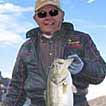 Rick Seaman is a fishing enthusiast with over five decades of fishing experience, a retired tournament fisherman, author of numerous published articles on fishing, and co-author of the book "Bass Fishing - It's not WHAT you throw, It's WHERE you throw it".
Rick Seaman is a fishing enthusiast with over five decades of fishing experience, a retired tournament fisherman, author of numerous published articles on fishing, and co-author of the book "Bass Fishing - It's not WHAT you throw, It's WHERE you throw it".
 Contact Information
Contact Information
Hell Creek State Park
2456 Hell Creek Rd
Jordan, MT 59337
406 557-2362
Fishing lakes in each state
102225
Fort Peck Lake, Montana Report
MONTANA


Information about fishing lakes in Montana
Fishing in northeast Montana for bass, catfish, crappie, walleye, perch, salmon and pike.





